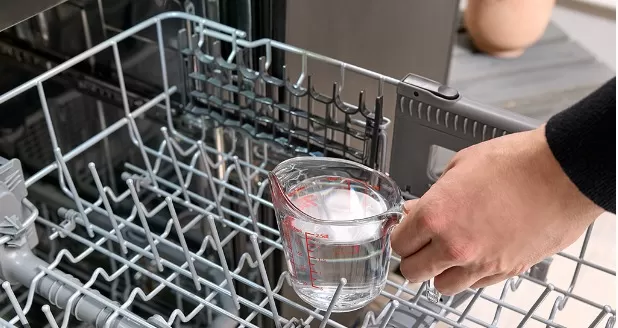Discover vinegar’s versatile household uses beyond salads. From repelling insects to removing rust and cleaning various surfaces, this inexpensive kitchen staple is a powerful multitasker. Explore the handy and surprising ways vinegar can help you around the house.
The Power of Vinegar: Surprising Household Uses

Vinegar, a common pantry staple, offers more than just its culinary uses.
With its high acidity and versatility, vinegar can be a powerful tool for various household tasks. From stain removal to cutting through tough grime, vinegar’s effectiveness extends beyond the kitchen.
Here are some surprising ways you can utilize vinegar around the house:.
All-Purpose Cleaner: Mix equal parts water and vinegar in a spray bottle to create a natural and effective all-purpose cleaner.
Use it to clean countertops, glass surfaces, appliances, and more. The acidity in vinegar helps remove dirt and grime, leaving surfaces sparkling clean.
Stain Remover: Treat stubborn stains on clothing, carpets, or upholstery with vinegar.
Blot the stain with a mixture of vinegar and water, let it sit for a few minutes, then wash or rinse as usual. Vinegar can effectively break down and lift many types of stains.
Deodorizer: Combat unpleasant odors in your home by placing a bowl of vinegar in the affected area.
Vinegar’s acidic properties help neutralize and absorb odors, leaving your space smelling fresh. You can also use vinegar to remove lingering odors from items like cutting boards, lunchboxes, or refrigerator interiors.
Lime Scale Remover:.
Say goodbye to lime scale buildup on faucets, showerheads, or coffee makers.
Soak a cloth or sponge in vinegar and wrap it around the affected area. Let it sit for a few hours or overnight, then scrub away the residue with a brush.
The acidity of vinegar helps dissolve and remove mineral deposits.
Weed Killer:.
Keep your garden free of unwanted weeds by Using Vinegar as a natural weed killer.
Fill a spray bottle with undiluted vinegar and spray it directly onto the weeds. Be careful to avoid spraying desirable plants, as vinegar can be harmful to them as well.
Pet Odor Neutralizer:.
If your furry friend has an accident, vinegar can help eliminate the odor.
Mix vinegar with water and use it to clean the affected area. The acidity of vinegar helps neutralize and eliminate pet odors.
Dishwasher Cleaner:.
Remove residue and odors from your dishwasher by placing a cup of vinegar on the top rack and running an empty cycle.
Vinegar will help break down grease and soap scum, leaving your dishwasher fresh and clean.
Remember to always test vinegar on a small, inconspicuous area before using it on sensitive surfaces.
Additionally, while vinegar is generally safe and non-toxic, avoid using it on natural stone surfaces such as marble or granite, as the acidity can cause damage.
Harness the power of vinegar to replace chemical cleaners and tackle various household tasks in an eco-friendly and cost-effective way.
Natural Garden Pest Control: DIY Insect Trap with Vinegar
Keeping insects under control in the garden can be a challenge, but you don’t have to rely on harmful chemicals.
Create an earth-friendly insect trap using vinegar to effectively catch and control pests. Follow these simple steps to make your own DIY insect trap:.
Gather Your Materials
You will need a closed container with a lid, apple cider vinegar, small slices of banana peel, and cold water.
Prepare the Trap.
In the closed container, pour a cup of apple cider vinegar.
Apple cider vinegar acts as an attractant for many types of insects, including fruit flies. Add in small slices of banana peel, which will enhance the attractiveness of the trap.
Finally, pour in 1 cup of cold water.
Shake and Set.
Securely close the container and shake it gently to mix the ingredients.
Then, using a sharp object, such as a nail or a small drill, poke several small holes in the lid or around the top of the container. These holes will serve as entry points for the insects.
Placement and Monitoring.
Place the trap in your kitchen or near the infestation area.
Fruit flies and other insects will be attracted to the scent and enter the container through the holes. Monitor the trap regularly to see how effective it is in catching critters.
Replacement.
As the trap fills up with insects, it may become unappealing or too full.
Once the trap becomes too gross or loses its effectiveness, discard it in a sealed bag and replace it with a fresh one. Creating a new trap regularly ensures its optimal performance.
This DIY insect trap provides a natural and eco-friendly solution for controlling pests in your garden.
By using apple cider vinegar and banana peel, you can effectively attract and capture fruit flies and other insects without the need for harmful chemicals. Remember to dispose of the trap properly and replace it as needed.
Note: This trap may be specifically effective for fruit flies but may not work as effectively for other types of insects.
If you have specific pest problems, it’s recommended to explore targeted methods for those particular pests.
Maintain a Sparkling Clean Dishwasher: Vinegar Cleaning Method

While your dishwasher diligently cleans your dishes, it’s important to give it some care as well.
Over time, soap residue and buildup can accumulate inside the dishwasher, affecting its performance. By incorporating a simple vinegar cleaning method into your routine, you can keep your dishwasher in squeaky clean shape.
Follow these steps to wash your dishwasher:.
Prepare the Vinegar Solution: Start by pouring 1 cup of vinegar into the bottom of the dishwasher tub.
White Vinegar is a natural cleaning agent that helps dissolve soap residue and remove mineral deposits.
Empty the Dishwasher: Ensure that the dishwasher is empty, with no dishes or utensils inside.
This cleaning cycle will be dedicated solely to cleansing the dishwasher itself.
Run a Cycle: Close the dishwasher and select a hot water cycle.
Choose a cycle without any additional detergent or dishes. The hot water, combined with vinegar, will help break down and remove the built-up residue.
Wipe Down the Interior: Once the cycle is complete, open the dishwasher and carefully wipe down the interior with a clean cloth or sponge.
Pay attention to areas prone to residue accumulation, such as the spray arms, door edges, and around the drain.
Check and Clean Filters: Remove and inspect the dishwasher’s filters, which are typically located at the bottom of the tub.
Rinse them under running water to remove any trapped debris. Cleaning the filters regularly ensures optimal dishwasher performance.
Regular Maintenance: To maintain a clean dishwasher, repeat this vinegar cleaning method once every month or two.
Regular maintenance will prevent soap residue buildup and help keep your dishwasher functioning efficiently.
By incorporating this vinegar cleaning method into your dishwasher care routine, you can effectively remove soap residue and maintain a hygienic environment inside the appliance.
A clean dishwasher not only ensures cleaner dishes but also helps prolong the lifespan of the appliance.
Note: If you’re experiencing persistent issues with your dishwasher, such as unpleasant odors or poor cleaning results, it’s advisable to consult the manufacturer’s instructions or seek professional assistance.
Say Goodbye to Clogged Shower Heads: Vinegar Soaking Method

Is your shower head experiencing reduced water flow due to clogs? Don’t worry, you can easily tackle this issue using a simple vinegar soaking method.
By following these steps, you can restore your shower head’s functionality and enjoy a refreshing shower once again:.
Prepare the Vinegar Solution: Fill a bowl with boiling water and add 1/2 cup of vinegar to create a cleaning solution.
Vinegar is a natural acid that helps dissolve mineral deposits and unclog the shower head.
Submerge the Shower Head: If your shower head is removable, detach it from the shower arm and place it in the bowl of vinegar solution.
Ensure that the entire head is submerged in the mixture.
Soak for 10 Minutes: Let the shower head soak in the vinegar solution for approximately 10 minutes.
During this time, the vinegar will work to dissolve the mineral deposits and unclog the small openings.
Remove and Rinse: After the soaking time is complete, remove the shower head from the vinegar solution.
Use a soft brush or toothbrush to gently scrub away any remaining debris or buildup. Rinse the shower head thoroughly with water to remove any vinegar residue.
Alternative Method for Fixed Shower Heads: If your shower head is fixed and cannot be removed, you can still clean it using vinegar.
Fill a plastic bag with full-strength vinegar and partially immerse the shower head in the bag. Use tape or a rubber band to secure the bag in place, ensuring the shower head is fully covered.
Let it sit for approximately one hour to allow the vinegar to dissolve the clogs.
Final Rinse and Testing: After soaking or bag treatment, remove the bag or reattach the shower head.
Turn on the water to flush out any remaining vinegar or loosened debris. Test the water flow to ensure the clogs have been cleared and the shower head is functioning properly.
Regularly cleaning your shower head using this vinegar soaking method will help prevent clogs and maintain optimal water flow.
If you continue to experience issues or persistent clogs, it’s recommended to consult a professional plumber for further assistance.
Note: Exercise caution when handling boiling water and ensure the shower head is cool before removing or cleaning it.
*The information is for reference only.